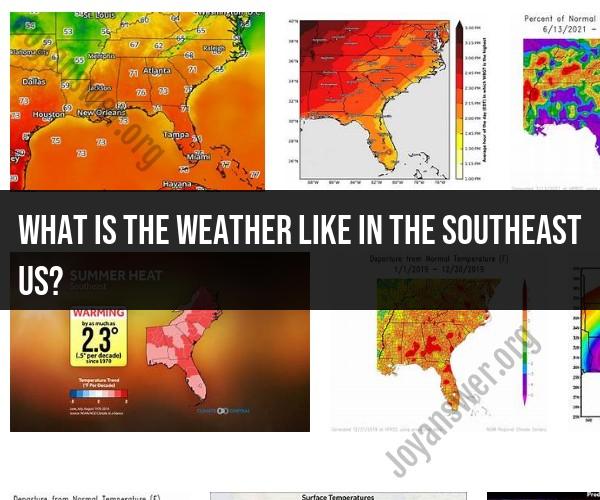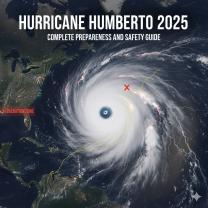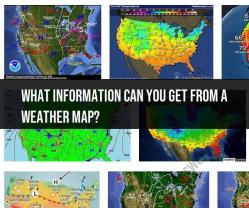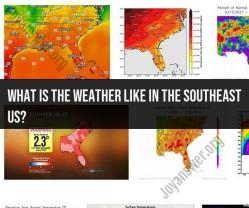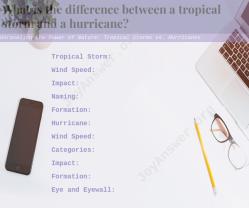What is the weather like in the southeast US?
The weather in the southeastern United States can vary depending on the time of year and specific location within the region, but there are some general climate and weather patterns that are characteristic of this area:
Hot and Humid Summers: Summers in the southeast US are typically hot and humid. High temperatures often exceed 90°F (32°C), and the humidity levels can make it feel even hotter. Thunderstorms are common during the summer months.
Hurricane Season: The southeast US, particularly states like Florida and the Gulf Coast, is prone to hurricanes during the Atlantic hurricane season, which runs from June 1st to November 30th. These storms can bring heavy rainfall, strong winds, and coastal flooding.
Mild Winters: Winters in the southeastern US are generally mild compared to many other parts of the country. While temperatures can drop below freezing, especially in northern areas of the region, snowfall is infrequent and usually light.
Tornadoes: Tornadoes can occur in the southeast, particularly in states like Alabama, Mississippi, and Georgia, during the spring and early summer months. Tornadoes can be a significant weather hazard.
Rainfall: The southeast US typically receives a good amount of rainfall throughout the year, with wetter conditions in the summer due to the afternoon thunderstorms and the potential for tropical storms or hurricanes to bring heavy rains.
Seasonal Variability: The southeast US experiences distinct seasons, with spring and fall providing milder and more pleasant weather compared to the extremes of summer and winter.
Coastal Influence: Coastal areas of the southeast, such as Florida, Georgia's coast, and the Carolinas, may have more moderate temperatures due to the influence of the Atlantic Ocean. These areas can also experience occasional sea breezes.
Frequent Thunderstorms: The southeast US is known for its frequent thunderstorms, especially in the afternoon during the summer months. These storms can bring heavy rain, lightning, and sometimes hail.
It's important to note that the southeastern US is a large and diverse region, so there can be variations in weather patterns and climate between states and even within individual states. For specific and up-to-date weather information for a particular location in the southeast US, it's advisable to consult a local weather forecast or a weather website or app.
Weather in the Southeastern United States: A Regional Overview
The southeastern United States is a region with a diverse climate, ranging from the humid subtropical climate of the Gulf Coast to the more temperate climate of the Appalachian Mountains. The region is also prone to a variety of severe weather events, such as hurricanes, tornadoes, and thunderstorms.
In general, the southeastern United States experiences warm, humid summers and mild, wet winters. The average temperature in the summer ranges from the mid-70s to the mid-90s Fahrenheit, while the average temperature in the winter ranges from the mid-40s to the mid-60s Fahrenheit.
The southeastern United States receives an average of 40 to 60 inches of precipitation per year. The most precipitation falls in the summer months, when thunderstorms and hurricanes are common.
The Southeast's Climate: What to Expect Throughout the Year
The southeastern United States experiences four distinct seasons: spring, summer, fall, and winter.
- Spring: The spring season in the southeastern United States is generally mild and pleasant. The average temperature ranges from the mid-60s to the mid-80s Fahrenheit. There is also a chance of rain or thunderstorms, especially in the afternoon.
- Summer: The summer season in the southeastern United States is hot and humid. The average temperature ranges from the mid-70s to the mid-90s Fahrenheit. There is also a high risk of thunderstorms, hurricanes, and other severe weather events.
- Fall: The fall season in the southeastern United States is generally mild and sunny. The average temperature ranges from the mid-60s to the mid-80s Fahrenheit. The leaves on the trees change color, and there is a chance of rain or thunderstorms, especially in the afternoon.
- Winter: The winter season in the southeastern United States is mild and wet. The average temperature ranges from the mid-40s to the mid-60s Fahrenheit. There is a chance of rain or snow, especially in the northern part of the region.
Preparing for Southeastern Weather: Seasonal Patterns and Variations
It is important to be prepared for the weather in the southeastern United States, no matter what time of year it is. Here are some tips for preparing for the weather in each season:
- Spring: Be prepared for thunderstorms and heavy rain. Keep an umbrella and raincoat on hand, and avoid driving through flooded areas.
- Summer: Be prepared for hot and humid weather. Stay hydrated, wear loose-fitting clothing, and avoid strenuous activity during the hottest part of the day. Also, be prepared for hurricanes and other severe weather events. Have a plan in place and know where to go if a storm warning is issued.
- Fall: Be prepared for mild weather and the possibility of rain or thunderstorms. Keep an umbrella and raincoat on hand, and avoid driving through flooded areas.
- Winter: Be prepared for mild and wet weather. Keep an umbrella and raincoat on hand, and drive carefully in wet conditions.
Here are some additional tips for preparing for the weather in the southeastern United States:
- Monitor the weather forecast: Always monitor the weather forecast before you head out for the day. This will help you to be prepared for any potential severe weather events.
- Have a plan in place: If a severe weather event is forecast, have a plan in place. Know where to go and what to do in case of a tornado, hurricane, or other emergency.
- Assemble an emergency kit: Assemble an emergency kit that contains food, water, first aid supplies, and other essential items. Keep your emergency kit in a safe and accessible location.
By following these tips, you can be prepared for the weather in the southeastern United States, no matter what time of year it is.
